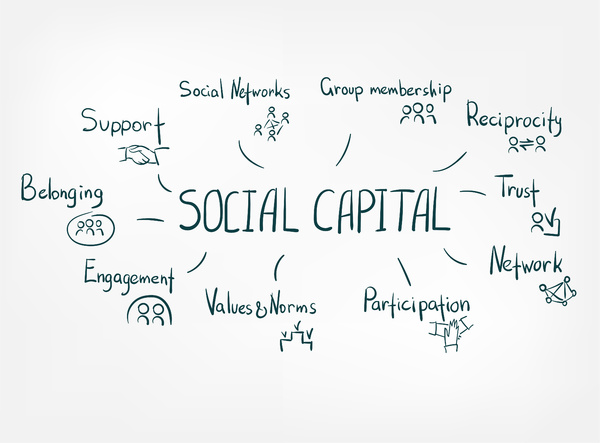THE WORLD’S #1 EXECUTIVE COACHING AND BUSINESS COACHING BLOG SINCE 2017.
What is Social Capital and How Can You Train Employees to Work Better in Groups?
February 8, 2022 | Category: Blog, Intelligent Leadership | Last updated on: March 12, 2025
Social capital is an ingredient that allows some teams to be more successful and productive than others. To stimulate the development of social capital, leaders and managers can create environments that encourage camaraderie between team members in subtle and non-intrusive ways.
Social capital is the sum of connections, trust, reciprocity, and knowledge among team members that defines team culture and explains why one team works better and is more productive than another. Social capital acts as the glue that holds together the abilities and skills of the team, turning them into a more focused whole.

Trust is a building block of social capital.
Why Social Capital Matters
The individual intelligence, knowledge, and competence of team members form the basis of a potentially productive team. To fulfill its potential, the team needs a special ingredient. This ingredient is social capital.
Social capital allows the team to play to its combined strengths while limiting its weaknesses. It encourages individual engagement, lending a positive context and a clear purpose to the activity of the group.
Social capital is an indispensable ingredient of healthy and just organizational cultures. In turn, such cultures generate social capital.
How does an organization benefit from rich social capital? Organizations enjoying plentiful social capital:
- Have easier access to financing
- Find it easier to promote organizational learning and reap its benefits
- Gain the ability to enter strategic alliances
- Secure protection against takeovers and outside threats
- Benefit from viral marketing
How can company leaders help build social capital?
Building Social Capital
Building social capital is a sensitive issue since social capital doesn’t exist in isolation. Most often, it manifests as a part of a virtuous circle, fuelling something like positive company culture or creative conflict. The latter then facilitates social capital.
The goal of a leader is to establish the circumstances conducive to such positive processes within the organization. Once the “reaction” starts, it soon becomes self-sustaining and self-propagating.
Leaders can focus on trust and empathy as the initial sparks to trigger the social reaction that results in social capital. In my leadership coaching books, I have always considered trust and empathy as the building blocks of healthy organizational cultures.
Facilitating Work-related Connections
Leadership coaching professionals have long advocated the sharing of work experiences among employees as a way of facilitating mutual trust, engagement, and social capital. Leaders can:
- Get employees from different organizational divisions to team up and accomplish tasks together.
- Give employees and managers opportunities to share something they have recently learned with the rest of the organization.
- Introduce team-building exercises that focus on empathy.
Allowing Employees to Create Their Value
Employees feel valued and engaged when they can meaningfully contribute to the team dynamic. Allowing employees to actively contribute lets them accrue personal value and become reservoirs of positive experiences for their peers.
To allow their reports to blossom into contributors, managers and leaders have to avoid micromanagement. At the same time, they have to create an environment that encourages and rewards employees for developing their skills and teaching others what they know.
Facilitating Casual Connections
People are more likely to establish rapport and create social capital, communicating and interacting in casual settings. Executive coaching professionals understand the value of casual connections all too well.
People interact better in casual settings.
To facilitate such connections in their organizations, leaders can:
- Create opportunities for their employees to engage in casual conversations at the water cooler or coffee machine.
- Encourage people to eat lunch together instead of retreating to their desks.
- Introduce small-talk to meetings, lightening the atmosphere and allowing participants to interact on a personal level.
- Set aside company time for people to share stories about their personal lives and interests.
- Avoid coercion. Some employees will love to share aspects of their personal lives with their coworkers. Those shier and socially awkward will not enjoy being the center of attention.
Focusing on Subtle Actions Over Mandatory Team Building
Allowing a team to develop its culture and social capital is about identifying small gestures of camaraderie among team members and building on these subtle interactions. Encouraging team members’ efforts to help one another builds more social capital than any preplanned team-building activity.
Do you want to learn more about business coaching and intelligent leadership? Check out my books.



